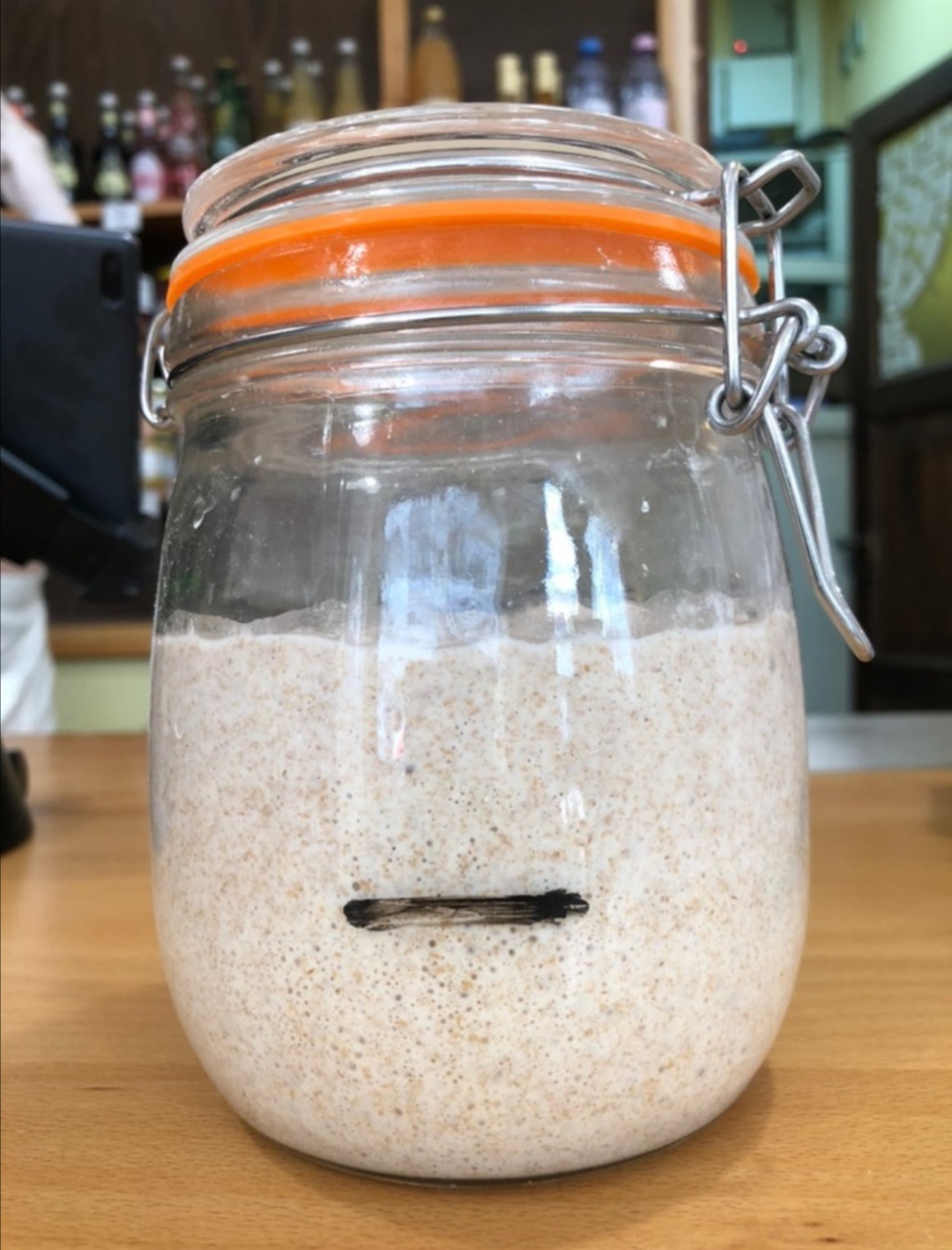If you would like to make your own sourdough, first of all you need a ‘starter’ to kick off the whole process. Below is a procedure for how to create your own naturally rising sourdough starter at home. It’s very simple, you just need a bit of time, but since we all have to stay inside, there is plenty of time to try new things.
Once the starter regularly produces bubbles and is doubling in volume, the process is reasonably quick. You can keep it in the fridge on the days when you’re not baking. This will slow the fermentation down dramatically, but not 100%. It will become liquid and acidic over time and therefore needs to be refreshed before using it to make a bread dough. If you are baking 2-3 times a week, this will not be a problem and you will not have to do extra refreshes. If you are baking once every 2 weeks or so, you will need to refresh it twice before baking. Normally between 6-12 hours after the refreshment process, your starter will be lively enough to use to make a bread dough.
We can use white flour or whole wheat, both will work. Whole wheat will generally rise quicker but can also be more acidic . White spelt flour can be found easily and this is an interesting flour which can sometimes be digested easier than wheat flour. I find spelt flour has a nuttier taste than wheat flour.
In this process we start the fermentation using an apple, but it could be replaced by a pear or some raisins if you have some. The process remains the same. A sourdough can also be made without any fruit at all, but may take longer. The bacteria and sugars found in the fruit aid the growth of natural yeasts found in the flour. In the first few stages of building the starter, you will need to discard some. It will triple in quantity at each refresh, it is not necessary to refresh the total quantity, as you will end up with way too much. These leftovers are not really going to be strong enough yet to make a bread rise. Wait until the sourdough is doubling regularly before making a bread dough.
1st stage
- 1 apple (organic preferably)
- 300ml water
Wash the apple and cut roughly into 2-3cm cubes. Don’t peel it, the skin helps! Put the apple into a clean glass jar and cover with 300ml warm water. Keep it in a warm place, preferably at around 25 degrees , for 2-4 days, or until the you can see bubbles of gas forming around the apple. This shows the natural fermentation is beginning. It should smell slightly sweet and sour, almost like a cider. The exact time of the fermentation will depend on the apple as well as the room temperature. If mould starts to form, the process has gone too far and you will need to start again with a different apple. Open the jar from time to time, check the aroma and follow the development of your little friend.
2nd stage
So after a couple of days, you will see activity in the water. You will use this water and mix with flour to build your sourdough starter. Strain the water and discard the apple. Weigh 100g of this water and add to it 100g of flour. Mix gently until the flour is dissolved. If you don’t have a scale, use 1 cup of this water to 1 heaped cup of flour. Return the mixture to the jar, close it and leave it in a warm place, around 25 degrees, for 24 hours. The jar needs to be twice the size of the quantity of starter, as it will eventually double in size. Draw a line on the side of the jar at the level of the starter before fermentation. This allows you to see easily how much it develops. Try to become used to the characteristics of your sourdough starter, and monitor how long it takes to rise. After 24 hours check the starter; see if it has created bubbles of air and doubled in size. If so, we can proceed with the first refresh. If nothing has happened, wait some more!
3rd stage
First refresh – weigh 50g of the risen sourdough starter, and add to that another 100g warm water at 30 degrees. Mix together, then mix in 100g flour. It is not necessary to mix a lot, just until the flour has roughly absorbed the water. Put the mixture back in the jar, note the level of the sourdough, then leave it again until the next day. You can discard the other 150g of sourdough that is leftover, or maybe use it to start a second sourdough, using another flour, and watch the differences in development. On the third day, check the activity of your starter again. It should have doubled again in volume and should have bubbles of different sizes. If it has collapsed in on itself, this means it had reached its limit and is now over fermented. If this happens, it’s not a problem, another refresh will bring it back.

4th stage
Second refresh – refresh once again, using the same recipe and method as the first refresh. Mix and leave again for about 12hours. On the fourth day, you should have a mature, creamy sourdough, with bubbles, both large and small. It should smell fruity and with a slight lactic aroma, similar to yoghurt or crème fraiche. To taste it can be slightly acidic, but not like vinegar. The main aspect to check is that it has doubled in size, if so, carry out another refresh, this time with only 40g of sourdough. Then add 100g water and 100g flour, and wait another 8-12 hours for it to rise again.
So now you have 240g of sourdough, you can use 200g to make bread, leaving 40g to refresh for the next bake. Depending on how much bread you want to make, you can always double the proportions of the refresh – ie, mix 40g sourdough starter and 200g water and then add 200g flour (it will just take a little longer to rise), then you will end up with 400g mature sourdough to bake with and 40g leftover to refresh. The important part is to always keep a little bit of the starter, enough to refresh for your next bake, so you don’t have to start again with the apple.
If looked after properly and refreshed regularly, your sourdough starter will last for years, creating countless delicious loaves for you to enjoy.
Hope you liked this recipe. If you tried it at home, please let us know how it went, we can't wait to see pictures of your sourdough and the whole process. Otherwise, you can find this recipe in Romanian here: Cum să faci maia acasă, în 4 pași simpli.

